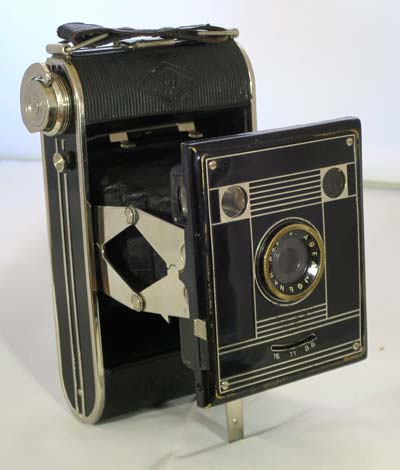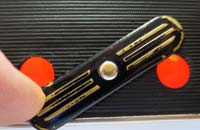Agfa Billy Clack No. 51
Specification

| Manufacturer | : | Agfa |
|---|---|---|
| Produced | : | 1934-1940 |
| Classification | : | Medium Format |
| Body Type | : | Folding Strut |
| Construction | : | Metal |
| Film Type | : | 120 |
| Film Width | : | 62mm |
| Image Size | : | 2¼ x 1⅝ in |
| No. of Images | : | 16 |
| Lens Type | : | bilinar achromat |
| Focus Type | : | Fixed |
| Focal Length | : | 70mm |
| Focal Range | : | 7ft - inf. |
| Aperture Type | : | Multihole |
| Apertures | : | f/8.8, f/11, f/16 |
| Shutter Type | : | Rotary |
| Shutter Speeds | : | B,I(1/30 sec) |
| Size Open (w x h x d) | : | 85 x 165 x 105 mm |
| Size Closed (w x h x d) | : | 85 x 165 x 36 mm |
| Weight | : | 485g |
Art Deco Credentials
![]()
![]()
![]()
![]()
![]()
Iconic: Famous, well-known and celebrated
- Produced during the main Art Deco period.
- Symmetrical geometric design on front panel.
- Raised chrome strips and glossy black enamel on sides.
- Fine chevron pattern in leatherette covering;
- Chrome struts.
- Concentric circles on film door latch, lens plate release and film winder.
Description
The Billy-Clack No.51 is one of two strut-folding cameras made by Agfa from about 1934 to 1940. The two models have different formats. The Agfa Billy Clack No.51 takes sixteen 4.5×6 cm pictures on 120 film whereas the Billy-Clack No. 74 takes eight 6×9 cm pictures on 120 film. The name 'Clack' was used for simple cameras made by Rietzschel before they and Agfa merged. In some countries they were sold with the name Speedex

The Billy-Clack No. 51 has an f/8.8 Igenar lens ('Jgenar'; the name probably refers to Agfa's being part of IG Farben), a periscopic doublet lens with three aperture settings (f/8.8, f/11 and f/16), which are achieved by switching between fixed-size apertures. It has a simple 'I' and 'B' shutter, brilliant finders for landscape and portrait orientation. This camera has a yellow filter for black & white shots, which can be swung into place using a lever underneath the face plate.
Like many folders of its age, it has a winding key, not a knob. It has two red windows, with a swivelling cover, which are used to get 16 exposures from 120 film. The film is advanced until a number appears in the first window and an image is taken. Then the film is advanced until the same number appears in the second window. Then it's back to the first window for the next number.
Early examples are covered with leatherette with vertical stripes impressed above the Agfa rhombus logo. Later cameras, like the one shown here have the fine chevron patterned covering.
How to Use
The Billy-Clack takes good quality snaps with 120 film, which is easily available. As the shutter speed is only 1/30s, it is advisable to use a tripod to get clear shake free images. However, holding it against a wall or other solid object would work as well. For quick snapshots, hold it firmly against your body. Don't worry too much about exposure values, the latitude of modern films is good. With ISO 100 film use the aperture f/16 for sunny days, f/11 for hazy days and f/8.8 for cloudy days.